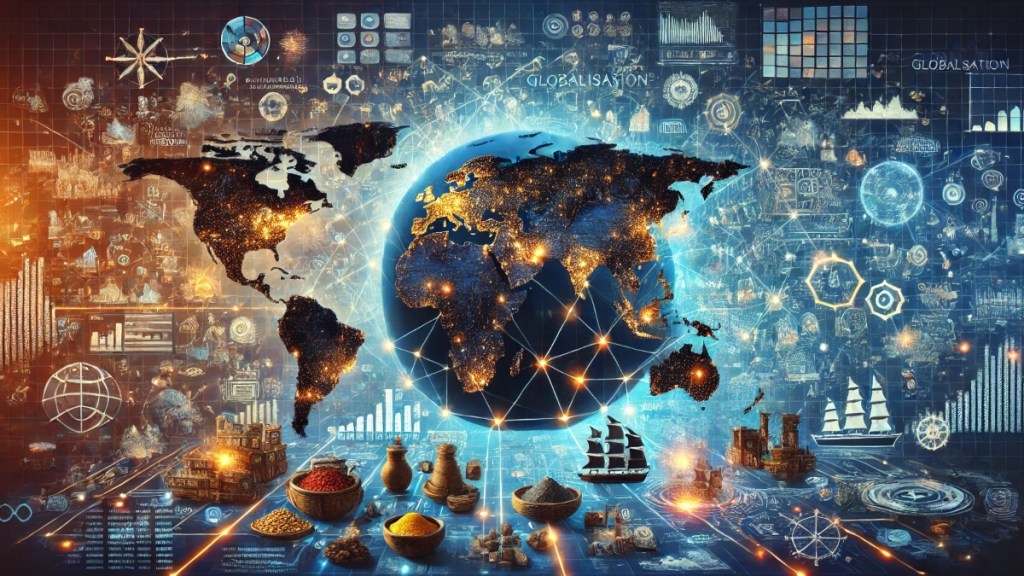By Anita Inder Singh
Globalisation, a complex phenomenon, is about the growth of interdependence across continents rather than just regions or within states. Further, the internet facilitated instant global communication.
Globalisation has survived financial crises, the worldwide Covid-19 health emergency, and political instability. Improved international collaboration has increased global capital flow.
Global trade in goods and services has made a strong comeback after the pandemic, although recovery has been unequal across areas.
Globalisation will also survive Donald Trump 2.0 and his mercantilist threats, but it also faces challenges from the economic and political upsets triggered by Russia’s invasion of Ukraine.
For centuries, issues as varied as war, migration, and technological change have added layers of global connections. They did not take place in just one country or one continent. Chinese and Indian tea, spices, and handicrafts made their way into Europe centuries ago, long before the word globalisation was coined.
At another, political, level, India’s first Prime Minister Jawaharlal Nehru stressed that post-colonial countries had a global role to play and had no intention of being ignored, passed by, or led by the nose by more powerful countries. Indian independence and nonalignment meant that hundreds of thousands of Indians would no longer serve in the British-Indian armed forces, and that struck at the core of Britain’s global military power in the mid-20th century.
And in the 21st century, emerging market economies, some of them former western colonies, want political choices and multiple trading partners to navigate an interdependent world.
Military and economic rivalry does not augur the end of globalisation. The rivalries between the US and China or India and China will not end their economic linkages. An analogy can be drawn with Germany and Japan, which were among the US’ largest trading partners in the early 20th century. They fought the US in the Second World War but became its allies after 1945, creating a new international order.
Since invading Ukraine in 2022, Russia has continually threatened a third world war and even nuclear strikes. But Russia’s most important strategic partner, China, recognises the link between economics, strategy, and great power in the 21st century, and may prefer the international peace essential for globalisation so that it can increase its economic clout worldwide, even as it claims the territories of most neighbouring countries.
Authoritarian China’s economic rise makes it a strategic threat, so western democracies wish to reduce their dependence on China. But trade between them and China. and between India and China continues to grow, the latter despite a longstanding border conflict.
Globalisation is continuous and spreading. While China’s share of the US’ imports dropped from 21% to 17% between 2018 and 2022, US imports from Vietnam, Bangladesh, and Thailand rose by more than 80%.
The section of India’s economy that benefited most from globalisation after the 1990s was computer software. India’s trail-blazing software city, Bangalore, became a synonym for foreign jobs lost to outsourcing.
Globalisation has also encouraged foreign investment in India, though it has never reached the heights of FDI in China. Unfortunately, FDI in India has fallen from net inflows of 3.6% of the GDP in 2008, 2.4% of GDP in 2020, 1.4% in 2021, and further down to a mere 0.8% in 2023. India does need to make its business environment more investor-friendly if it is to remain securely and fruitfully on the rails of globalisation.
With the recent deterioration of political relations between China and the West, some multinational corporations hoped to shift to India, but India has failed to take sufficient advantage of China’s relative economic sluggishness.
India intends to achieve aatmanirbharta (self-reliance) to reduce imports. Aatmanirbhar Bharat is intended to produce goods for Indian as well as foreign markets. But it does create the idea that imports will be restricted, and thus go against globalisation? Over the last decade, the BJP government has raised import duties on a wide range of goods, and the average import duty rose from 15% in 2020 to 18.3% in 2021, India’s old problems of education, unemployment, and the environment block its way to becoming a more active player in a globalised world.
Despite boasts about economic growth, India is simply not creating enough jobs. The labour participation rate is barely 40%, and the urban female participation rate is estimated at being below 6%. These rates, among the world’s lowest, also highlight the waste of India’s much-vaunted demographic dividend.
Last but not least, progress can celebrate ethnic and religious diversity as well as a capacity to become a global player. In the 18th century, when India was ruled by a mix of Hindu, Muslim and Sikh dynasties, its share of the world economy was around 23%. In 2023, that was 7.93%. That was much better than the 2% that existed when it achieved independence from British rule in 1947, but less than half of China’s, which was nearly 19% in 2023.
The lesson is that India’s diversity is not a barrier to the progress that can emerge through globalisation. But, a narrow nationalism, which sparks socio-political violence and stifles entrepreneurship, is an obstacle to India’s ability to contribute to socio-economic flows that will be nationally and globally compatible.
India should refresh its development strategy. For globalisation will endure, though it will change, as states craft new economic and social policies to advance national and international interests.
The author is Founding professor of Centre for Peace and Conflict Resolution, New Delhi. Views are personal.
(Disclaimer: Views expressed are personal and do not reflect the official position or policy of Financial Express Online. Reproducing this content without permission is prohibited.)

